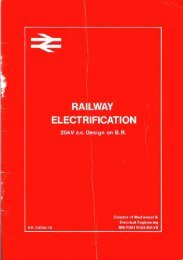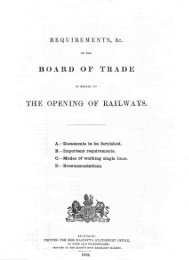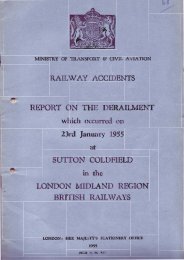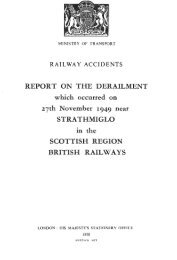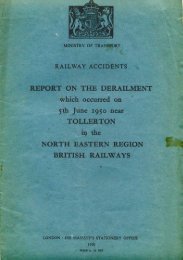R A I LT R AC K - The Railways Archive
R A I LT R AC K - The Railways Archive
R A I LT R AC K - The Railways Archive
Create successful ePaper yourself
Turn your PDF publications into a flip-book with our unique Google optimized e-Paper software.
Route characteristics<br />
DESCRIPTION <strong>The</strong> Great Western Main Line (GWML) is the principal rail<br />
route from London to the West of England and South Wales. <strong>The</strong> route<br />
between Paddington and Didcot is a four-track railway. West of Didcot the<br />
route is primarily two track, though with four tracks between Severn Tunnel<br />
Junction and Cardiff. Linespeed between London and Bristol Parkway and<br />
Chippenham is 125mph; elsewhere it is 75–100mph. <strong>The</strong> slow lines between<br />
Paddington and Didcot are restricted to 60–100mph.<br />
MAJOR STATIONS<br />
London Paddington <strong>The</strong> construction stage of Phase 1 of our redevelopment<br />
proposals for this station is due to be completed by mid-1999. This will provide<br />
an airline check-in facility for the Heathrow Express Rail Link, escalator access to<br />
the enlarged London Underground concourse, and a new mezzanine area to<br />
provide a food court and improved retailing facilities. For Phase 2, we are<br />
planning improved station and concourse facilities for Platforms 9–12.<br />
In addition, we are continuing to work towards meeting our customer<br />
requirements in relation to improved ingress and egress for taxis and coaches in<br />
the departures road.<br />
BOTTLENECK ANALYSIS Two current bottlenecks were identified in the<br />
1998 NMS: Paddington–Reading–Basingstoke and Bath–Bristol–Severn Tunnel<br />
Junction. Didcot–Swindon was identified as a potential bottleneck. Until 2001,<br />
we plan that growth will be met through restructuring the timetable. In addition,<br />
we are committing to a programme of infrastructure enhancements, as follows, in<br />
order to accommodate future services.<br />
Paddington–Reading–Basingstok e A key bottleneck is the route section<br />
between Heathrow Airport Junction and Acton. This section is already operating<br />
at the limit of practical capacity (26 trains per hour) in the peak and close to the<br />
limit in a number of off-peak hours. We have identified a p r o g ramme of<br />
enhancements to meet a series of future customer aspira t i o n s .<br />
• Remodelling at Acton by 2002 to accommodate the proposed Heathrow–<br />
St Pancras two-train-per-hour service. This would create capacity for a total of<br />
28 trains per hour.<br />
Route vision<br />
Our vision for the GWML is for a world-class reliable high-capacity route serving<br />
the rapidly growing markets in the M4 corridor and at Heathrow Airport. We<br />
will provide high-quality passenger interchanges while keeping the heritage appeal<br />
of major Brunel Stations. We aspire to a fastest journey time of 1 hour 40<br />
minutes from Paddington to Cardiff.<br />
<strong>The</strong> route has witnessed strong growth over the last two years. Utilisation<br />
has increased by up to 35% on the main lines between Acton and Airport<br />
Junction in the peak. Route capacity is being fully utilised over some sections as<br />
identified in the bottleneck analysis, and reliability has suffered as a result. Our<br />
main priority is to improve reliability, with improving timetable robustness and<br />
high levels of asset performance being our first goals.<br />
We forecast that passenger demand on existing services will grow by<br />
around 30% over the next ten years. <strong>The</strong> Franchising Director and our<br />
customers have aspirations to run additional services that cater for this<br />
demand and to venture into new markets such as Heathrow Airport and<br />
London Services Orbital.<br />
• A later enhancement by 2006 of two additional tracks between Airport<br />
Junction and Southall, along with grade-separated junctions, would provide<br />
capacity to a total of 30 trains per hour, accommodating four trains per hour<br />
on the Heathrow–St Pancras service.<br />
• <strong>The</strong> option, in addition, of providing two extra tracks between West Ealing<br />
and Acton and creating an extended loop between Airport Junction and<br />
Slough by 2006 would give capacity of 34 trains per hour which would<br />
accommodate all customer aspirations on this route throughout the day.<br />
• Adding an extension of the two extra tracks between Southall and West<br />
Ealing by 2010 would provide further capacity to cater for growth in freight<br />
and suburban services, creating a total capacity of 42 trains per hour.<br />
In addition to these enhancements, we have identified a series of alterations<br />
elsewhere on the GWML to utilise the capacity generated by easing this key<br />
bottleneck. <strong>The</strong>se are: extra platforms at London Paddington, Bristol Temple<br />
Meads, Bristol Parkway and Swindon; Reading remodelling phase 2 (including one<br />
extra platform and improved access from the west); Didcot East crossover<br />
doubling; additional looping capacity at Swindon; Westerleigh Junction speed<br />
increase; Filton Junction remodelling; and Severn Tunnel additional signal section.<br />
Bath–Bristol–Se vern Tunnel Junction Analysis of this bottleneck showed<br />
that the following capacity improvements are required: an additional signal section<br />
in the Severn Tunnel; additional platforms at Bristol Temple Meads; and<br />
remodelling at Filton Junction. A possible later enhancement to accommodate<br />
Bristol light rapid transit is to install additional lines and stations from Bristol to<br />
Filton, including remodelling of Dr Days Junction.<br />
Didcot–Swindon Capacity is forecast to limit future growth by 2003. Measures<br />
include increasing looping capacity between Didcot and Swindon and increasing<br />
platform capacity at Swindon Station.<br />
We also expect significant increases in the number of freight trains.<br />
We will optimise and increase route capacity to meet the aspirations of the<br />
Franchising Director and our customers with a programme of route<br />
improvements. Shorter journey times on the GWML are important, to make rail<br />
more competitive with the M4 and so help to reduce the peripherality of South<br />
Wales and the South West. We will optimise the journey time achieved by<br />
existing rolling-stock and prepare to make the most of the potential offered by<br />
new vehicles.<br />
A further goal is to upgrade facilities, the passenger environment, carparking<br />
capacity and interchange opportunities at key stations, while keeping<br />
heritage character.<br />
We will also provide connections to a number of new and developing<br />
freight terminals and enhance route capability to handle freight intermodal traffic.<br />
161



